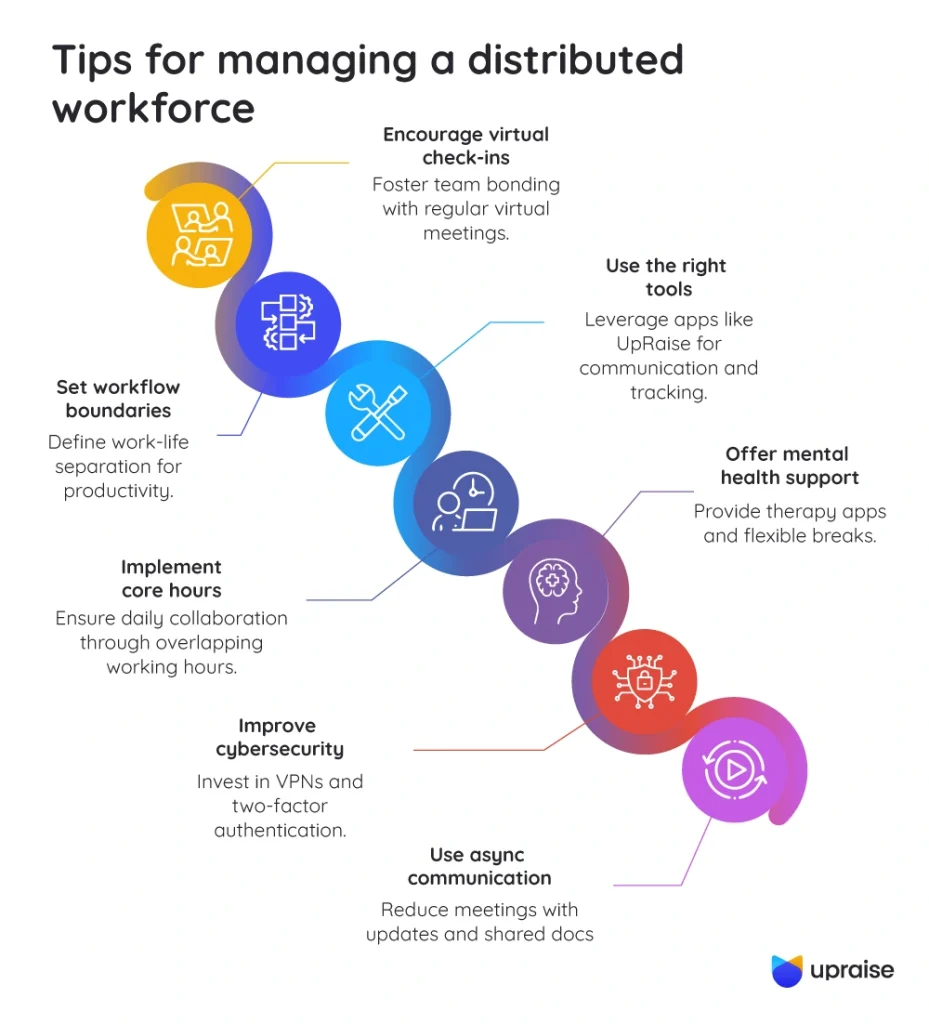Consider this: A newly launched software startup in the U.S. is struggling to build its product. The company is on a tight budget, whereas hiring skilled developers locally is expensive. The founders wonder if they can afford to compete with bigger players in the industry. What they don’t realize is that there’s a smarter way – they can tap into global talent at a fraction of the cost.
This is where a distributed workforce can save the day. Now, that same startup company can hire skilled developers from countries like India, Brazil, or the Philippines to reduce costs, speed up development and gain a competitive edge in the market. Besides offering the perks of a global labor pool, a distributed workforce allows companies to operate round-the-clock and improve work-life balance for their employees.
However, managing a remote team comes with its own set of challenges. There will be communication gaps, time zone differences and productivity concerns. Let’s explore the best strategies to successfully run a distributed workforce without compromising efficiency, collaboration and business growth.
What is a distributed workforce?
A distributed workforce refers to a team of employees who work remotely from each other, often from different geographical locations. Unlike centralized workplaces, a distributed workforce sees teams working remotely across different cities or even countries. You just get flexibility – no tight schedules, no long commutes. All you need is a systematic set-up of advanced tools to communicate and collaborate online.
What is a distributed organization?
A distributed organization is a management system where all employees work remotely from one or more locations. That doesn’t mean that all offices are far from each other; some or all may be in the same city. But for a company to be distributed, some employees must work in different locations from most of their colleagues.
The term decentralized organization is often used interchangeably with the term distributed organization. But there is a significant difference between the two. Decentralized organizations do not have a single point of control. Every entity operates as a separate unit. At the same time, a distributed organization refers to different locations connected to a central control point/main office.
Why is a distributed workforce important?
A distributed workforce is not just a trend. It’s a smart way of working. While this model empowers employees to maintain a work-life balance, it helps organizations to be more productive. But there is more to it.
A distributed workforce offers:
- Flexibility that grows talent: Nearly 26% of employees value flexible working hours and 15% value flexible work location as important job factors. A distributed organization offers these benefits which empower employees to grow naturally with improved work-life balance and greater job satisfaction.
- Cost savings: An average U.S. organization saves $11,315 annually per remote employee with a distributed workplace, freeing up resources for growth.
- Global reach: Easily hire new talents from anywhere in the world, no matter the location. Businesses feel empowered with global talents and it gives them a competitive edge.
So, in short, running a distributed organization makes your workforce flexible, saves you time and keeps employees happy and loyal.
Tips for managing a distributed workforce
Managing a distributed workforce can be challenging but rewarding. Here are some simple tips to help you build a successful remote team.

Encourage regular virtual check-ins
Schedule regular virtual check-ins and informal chat spaces to maintain team bonding. For instance, a senior developer in Canada can start virtual coffee breaks twice a week. Teammates from India and UK can leverage this opportunity to casually chat, share updates and build stronger connections despite working remotely.
Set clear workflow boundaries
Distributed organizations should strictly instruct team members to establish a dedicated workspace and set clear boundaries between work and personal life. Employees should also receive a one-time perk for home office setups with noise-canceling headphones to create a more productive work environment.
Integrate the right technology and tools
With the right tools, the distributed workforce can easily communicate, schedule and share files. These applications also help streamline processes and help track employee performance. For instance, the UpRaise for Employee Success app is built to simplify the performance management process between virtual teams, boosting employee success with dedicated Objectives and Key Results (OKRs). The app seamlessly integrates with Jira, reviews forms, provides customizable templates and integrates easily with your existing IT infrastructure.
Implement overlapping core hours
Implement overlapping core hours for real-time collaboration. For instance, a project manager in Australia can set a four-hour core working window with their U.S. team to ensure a daily collaboration for faster project execution.
Offer mental health support
Consider providing employees access to therapy apps like Headspace or BetterHelp for better stress management. Some distributed organizations also provide flexible breaks and no-meeting days to further lower mental pressure.
Improve cybersecurity
With employees working from different locations, companies should invest in VPNs, two-factor authentication and regular security training to protect data from unauthorized access. Because remote work increases security risks, it can be vulnerable to cyber threats.
Use async communication more
Instead of forcing everyone to be online at the same time, companies should use recorded updates, shared documents and team dashboards. This reduces unnecessary meetings and improves productivity.
By applying these tips, you create a work environment that is more productive, secure and supportive. Here is how they benefit your distributed team.
Benefits
Many companies realize that a distributed workforce is beneficial. These are just a few of the benefits you can expect:

- Offering mental health support and flexible work hours reduces stress at work, helping employees stay happier and more engaged.
- Investing in cyber security protects companies’ sensitive data from cyberattacks and legal issues.
- Async communication allows employees to focus on work instead of sitting through long video calls, improving efficiency.
- While employees feel trusted and supported while working in a distributed workforce, they are less likely to quit. This helps companies save money on hiring and training new employees.
- Hybrid work options help to prevent burnout and keep a healthier environment so that employees can be motivated.
- Using AI-driven workflow tools and automated updates, teams can make quick and informed decisions without waiting for manual reports.
These benefits directly support the success of a distributed workforce and help in productivity and cost-effectiveness.
Challenges
Working with a distributed workforce comes with numerous benefits. But, the process is not immune to challenges like:
Lack of F2F communication: Without in-person chats, it might be difficult for product managers to address delayed clarification, which often leads to unwanted revisions and project delays.
Distractions at home: Without a focused work environment, employees might often get distracted by kids, pets and random noises at home.
Time zone differences: When team members are spread across the globe, scheduling meetings and collaborating can get tricky.
Burnout due to working in isolation: Burnout in remote work is now a big issue. According to some reports, 69% of remote workers reported experiencing burnout due to blurred boundaries.
These challenges might seem tough, but with good communication, planning and the right tools, they can be easily addressed.
Remote work vs distributed workforce
Let’s see how remote work and a distributed workforce differ in structure, independence, and team operation through this simple comparison:
| Feature | Remote work | Distributed workforce |
|---|---|---|
| Definition | Employees work away from the office, usually from home, but still stay connected to a central office | Teams are spread across different locations with no central office to report to |
| Connection to the office | Connected to a central physical office | No single office. Team operates from various locations |
| Independence level | Moderate – guided by central office structure | High – employees work autonomously across locations |
| Key benefits | Flexibility, some structure and access to office resources | Greater flexibility, global talent access and increased autonomy |
| Best for | Companies looking for a hybrid model or occasional office work | Fully remote teams looking for autonomy and global reach |
Conclusion
A distributed workforce is a strategic shift for organizations to attain greater flexibility, double productivity and increase employee satisfaction. With this model, companies can tap into global talent, reduce costs and promote a good work-life balance.
However, this practice is not without challenges, such as communication gaps, time zone differences and cybersecurity risks. The solution lies in adopting advanced tools, prioritizing employee mental well-being and focusing on results over hours worked.
A well-structured distributed work system improves operational efficiency and drives innovation, making it a win-win for both employees and organizations.
Empower your distributed workforce with UpRaise for Employee Success – the smarter way to stay aligned, productive, and engaged.
FAQs
What is a distributed workforce?
It refers to a system where a company’s employee pool is divided into discrete teams operating independently of each other, often from different geographical locations.
How does a distributed workforce improve employee productivity?
A flexible work environment helps employees manage their time better, avoid long commutes and work in ways that suit them best. When people are comfortable and have control over their schedules, they tend to be more engaged and productive. Also, businesses benefit from continuous workflow across different time zones, keeping work moving 24/7.
What are the challenges of a distributed work environment?
While managing a distributed work environment, organizations face common challenges, like face-to-face communication gaps, synchronizing teams from different time zones and lack of team bonding.
How can companies effectively manage the distributed workplace?
A distributed workforce is easy to manage when there are clear KPIs to follow with clear communication protocols powered by the right technology. Otherwise, it will be difficult to track performance to evaluate individual and team productivity in the long run.
What industries benefit most from a distributed work model?
A distributed workforce model is ideal for industries that can thrive with remote collaboration and global talent access, such as:
- Technology and software development
- Digital marketing and content creation
- E-commerce and customer support
- Finance and accounting
- Healthcare and telemedicine
- Education and e-learning

